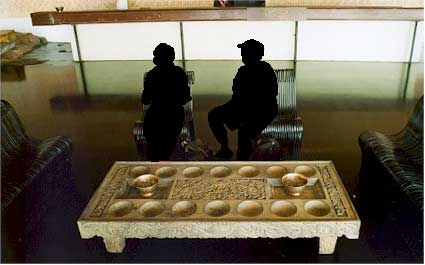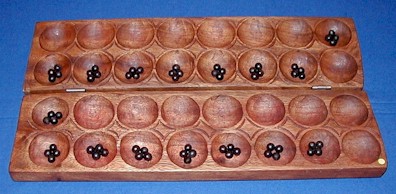|
|
I'm sure that by now everyone has played Mancala in the AF
Rec Room by now. And if you haven't, well, what are you waiting for? Get
yourself over there, pronto! But not too fast, because maybe you'd like to know
where this game came from. Where did it start? I know the answers, and if you'd
to learn more, read on! Because this is not a game that City Hall and her little
minons invented a couple of weeks ago... no, my friend, there's much more to it
than that.
It is very probable that Mancala is the oldest game in the world. Why? Because
you can play it with whatever happens to be around. Africans used to scoop out
holes in the earth and use little pebbles as stones, rings in the sand with
cowrie or other seashells, and what is usually used nowdays, a wooden board with
seeds. There have also been boards made of clay and gold
Mancala is an Arabic word, and is a generic name for this family of games. It is
the only ancient game that remains in the world that has an Arabic name. This
could mean two things: (1) it originated in Arabia or (2) it has existed in this
area of the world since ancient times (unlike in North America).
Mancala has been played for thousands of years in Africa and different parts of
the Middle East. There are also versions in India, Sri Lanka, Indonesia,
Malaysia and the Philippines. Because there are literally thousands of tribes in
Africa that play this game, each with small variations, it is hard to give this
game a name. Some examples of names include Wari, Warri, Ware, Walle, Awari,
Aware, Awaoley, Awele, Oware, Owari, and Wouri. You can also generalise the game
by the region of the world it comes from. Some examples include Bao, Soro (Choro
or Solo), Mangola, Gabata, Mulabalaba, Ayo and Sadeqa. Of all these varieties,
Wari is the most popular around the world and is very similar to the version in
Whyville.
There are many ways in which Mancala can vary. Any number of seeds can be placed
in the pits at the beginning. Personally, I have placed 3, 4 and 5 in each at
the beginning. My favourite is 5, although the game may tend to drag on at
times. There are also boards that have a different number of "ranks" and laps.
While in some parts of the world this game originated solely for recreation,
some regions, such as the West Indies have associated it with religion. It was
often played in a house of mourning, because it was thought that the spirit of
the dead would be amused until its body was buried. This is no longer the case,
however. It is believed that the religious traditions originated with slaves,
and these beliefs have since been forgotten or become obsolete.
When I was in grade 4, my class did a study of Ancient Egypt and one of the
activities was to play Mancala with a partner. After playing the game several
times, we made our own boards. If you'd like make you're own board all need are
a few materials!
MANCALA
You'll need:
One egg carton (the kind that holds a dozen eggs)
48 beans, seeds, marbles, etc.
2 tuna cans
Paint or markers
Instructions:
Paint the egg cartoon and the cans however you'd like, bright colours work best.
Let the paint dry. If you paint the insides of the cans, the paint may chip off
as you play. Play with family and friends, and tell them you learned it on
Whyville! You can always get instructions from the AF Rec Room if you need them.
Well, that's all folks! I'm off to play some Mancala at the Mind Game Olympiad,
so ta-ta for now!!


Sources:
http://www.tradgames.org.uk/games/Mancala.htm
http://www.game-club.com/cover1/mankrule.htm
http://www.historicgames.com/RPgames.html#Mancala
http://boardgames.about.com/gi/dynamic/offsite.htm?site=http%3A%2F%2Fwww.kidsdomain.com%2Fcraft%2Fmancala.html
|